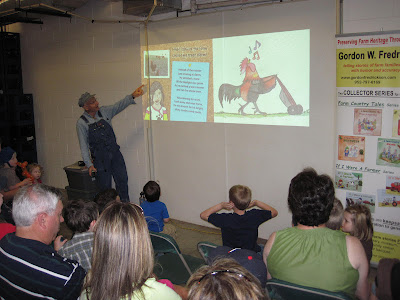Saturday was a great day to be outdoors, especially at the annual Milkapalooza Event at Cedar Summit Farm north of New Prague. The farm is owned by Dave and Florence Minar, who have turned it into a family operated dairy, featuring grass-fed animals on an orgainic farm. Unlike most other dairy farms, this farm processes the milk right on the premises and produces and sells great cheese, milk, and drinkable yogurt, which is really good stuff.
Vistors came early to get up close to the animals and ride on the wagon which toured the pasture.
An idyllic setting, don't you think?
Milkapalooza is a kind of customer appreciation day, although no one is going to check any customer ID cards for the free samples at the hospitality tent.
Customers stopped by early in the morning to sample a variety of products, including the very popular drinkable yogurt. Around noon everyone was too busy to take pictures.
And it's a vendor appreciation day too. Growers who supply the store with a variety of cheeses, jams, eggs, honey and other products have booths showing their produce. The picture above shows the tent of Chris and Lynette Brandt, who regularly provide Cedar Summit Farm with free- range chicken eggs.
Several bands provided vocal and instrumental music, including blues.
Customers from the Cities and the surrounding suburbs came in good numbers as children and adults enjoyed pony rides, pasture tours, and petting the cows and calves.
Do you recognize the guy from Minneapolis holding the milk bottle?
Mayor Rybak , who is holding the milk bottle, and his wife (far left) are friends of the owners of Cedar Summit Farm, Dave and Florence Minar. The mayor's father is from New Prague.
Both Mayor Rybak and his wife visited our booth and expressed interest in our "Made in Minnesota" products.
Brad Simon, illustrator of my latest book, What I Saw in the Farm, poses with me in front of our tent display of our books and farm heritage pictures.
Nancy and I consider ourselves very fortunate that Dave and Florence include us in on this special event. They invite us to set up a booth to sell our books and display our farm heritage photos.
Young children liked the old pictures at our tent, too!
Children loved to get close to the farm animals at Milkapalooza.
The ducks, below, are just too cute to not pick up, and children found them irresistible.
This youngster discovered how cuddly and friendly little ducks are.
If you talk to them, they will respond, in their own language, of course.
Calves and cows are as popular as they are central to the farm's success.
Beth, who is studying at NDSU to be a veterinary technician, stands by to answer the many questions customers have about the cows and to keep a keen watch, keeping people safe.
The grounds were full of activities, including pony rides offered by LeRoy Schoenbauer, and rides to the pasture and other tours of the farmyard offered by guides. Food for the event was catered by Valley Natural Foods, a retail store in Burnsville that stocks many of products produced by Cedar Summit Farm.
Since there were so many things to do, I was a bit concerned that no one would take take time to attend my free readings of What I Saw at the Farm, which I held in the storeroom on the west side of the main building.
But I was not to worry, Merrisue Minar graciously rounded up a large audience that left standing room only for my first show, which as was at 11:00 AM.
People also found time to browse and purchase my books.
My favorite thing to do is autograph a book for a child.
Standing next to me displaying his newly puchased book is Nathan Minar,
son of Mike and Merrisue Minar, and grandson to Dave and Florence Minar.
Nathan made my day at about 9:00 AM, an hour before the event officially began.
Nathan was at the farm early and like all the Minar grandchildren, he was busy helping with the details of preparation. However, when he saw our book display, he introduced himself and quickly began explaining that he had all of my books and he would be buying the new one too.
Gotta like that young man.
Cedar Summit Farm is a family operation with a couple of Dave's and Florence's sons and their wives working full-time while their grandchildren and their daughter and her husband help out during this event and other special occasions. We can only imagine the constant effort and attention to detail that makes this farm and store successful operations, and we thank the family for going to the extra effort of providing this Milkapalooza Event for customers.
Nancy and I thank the entire Dave and Florence Minar Family for inviting us to display our Farm Heritage books and photos at Milkapalooza. Family members had a very busy day, but they always took time to visit with people, answer questions, and thank people for coming.
We especially thank Merrisue and Linda Minar for their email updates that keep us posted and make us feel like an important part of their family farm event.
If you have not yet checked out the fine products offered at Cedar Summit Farm, go to their website
www.cedarsummit.com and plan a trip soon. It's not far and you will be glad you made the trip.
Photographs by Nancy A. Fredrickson













































